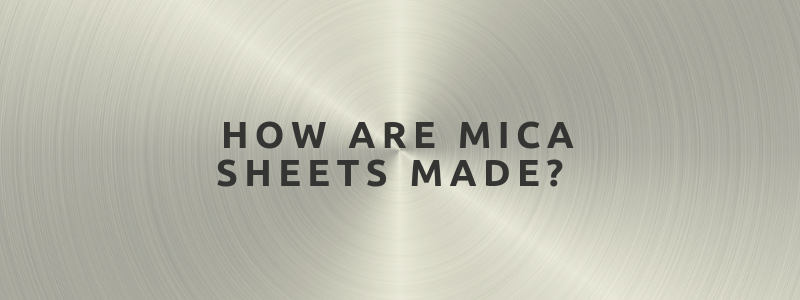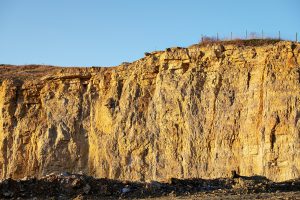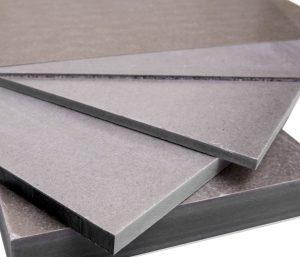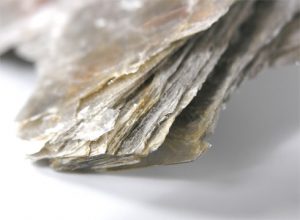
If you look at the end products and applications of mica, they can seem a long way from mica in its natural state. As a product, mica in sheet form is one of the most versatile, widely-used forms of processed mica, and here we answer how are mica sheets made?
Mica sheets come in different grades for a wide variety of applications. They can be either flexible or rigid, and can be composite or pure in composition.
Lets have a look at them.
Natural Mica
As a naturally-forming silicate mineral, mica occurs in igneous rock, which consists of layers of volcanic material. At this stage, mica is crystal in form and is mined to extract it.

These mica crystals come in irregular blocks, and while there are 37 kinds of this natural mica, it is the phlogopite and muscovite varieties which are used in a broad range of products and across different industrial sectors.
The richest natural sources of mica are coarsely grained igneous rocks known as pegmatites. Mining requires a high degree of precision, so as not to damage the crystals when extracting them.
This will either be open pit or deep shaft mining. The whole process of extracting natural mica is extremely labour-intensive, since the crystals must be hand-sorted, ready for processing. This involves the careful grading, splitting and cutting of mica crystals.
Mica crystals are formed in distinct layers and are in fact known as sheet silicates. This aids the manufacturing cycle of turning raw mica into mica sheets.
Mica sheets come in flexible and rigid grades. This gives mica sheets a certain versatility when it comes to their many different uses.
Both phlogopite (green) and muscovite (white) mica are used in flexible and rigid mica sheets. Elmelin provides these in a range of sizes. Phlogopite mica tends to be softer, while the muscovite variety has good dielectric qualities, combined with chemical resistance.
How Are Composite Mica Sheets Made?
In composite sheet form, mica is combined with other materials to further bolster its natural strength and adaptability.

One means of doing this is by first grinding down the mica into particles, using micro-pulverising equipment. Combining these particles with water and a colloid substance suspends the particles. Once added to a mesh mould, the substance’s viscosity means it becomes evenly distributed and forms into sheets.
In this sheet form, mica is flexible but resilient, with thermal, mechanical and electrical properties that put it in the forefront of various industrial insulation solutions.
Elmelin’ s specialist manufacturing capabilities, mean we can provide paper-thin mica sheets that offer high-performance and durability.
We can also bond resin to the mica sheet manufacturing process, which then provides another element to strengthen this already versatile product.
This process involves hard-pressing mica sheets together with a resin element, using a combination of hydraulic pressure and intense heat. We can do this to different thicknesses, depending on the final grade of mica sheet we wish to produce.
The Benefits of Mica Are Everywhere
Mica sheet’s multiple uses and functions mean that it appears in many industries, but functions behind the scenes, so you may not be aware of how prevalent it in fact is.
In power electronics, mica sheet carries out essential functions as a dielectric insulator, able to withstand intense electric fields while maintaining its structural integrity. This is vital in an industry where integrated functions are a basic requirement, and where single materials must therefore be extremely versatile in their working capabilities.
When manufacturing consumer appliances, rigid mica sheet is used to provide insulation where there is a requirement for an electrical heating element. This applies to everyday items such as toasters and hairdryers. Mica sheet’s thinness allows for rapid heat transfer and cooling of heating elements. At the same time it offers excellent thermal resistance, providing robust support to wire windings and heating spirals.
In the construction of furnaces, rigid mica sheets provide insulation for floors and other surfaces; while flexible mica sheets provide an essential re-lining material, extending the lifespan of furnace linings.

Foundries depend on mica-based insulation materials to support their processes, helping to both prevent heat loss and increase capacity. Composite mica helps ensure optimum processing temperatures, combining lightweight versatility with inherent robustness.
Increasingly, mica’s multi-application properties mean that has become fundamental to many processes and products.
Could You Benefit from Mica Sheets?
As we’ve summarised here, mica sheets, whether rigid or flexible, phlogopite or muscovite, serve different industries and sectors. They offer essential manufacturing support and can be integral to certain processes.
Mica’s heat resistance make it widely adopted in manufacturing where industrial insulation and thermal management are basic requirements.
Mica sheet also offers scalable solutions. In rigid form it can offer insulation solutions for large surface areas like foundry floors, but also small parts and components, as found in consumer appliances.
It might be the missing part of your manufacturing puzzle, or the solution to heat resistance and fire protection in your continuous processes.
Please talk to us to let us help you find the solution you’re looking for.
